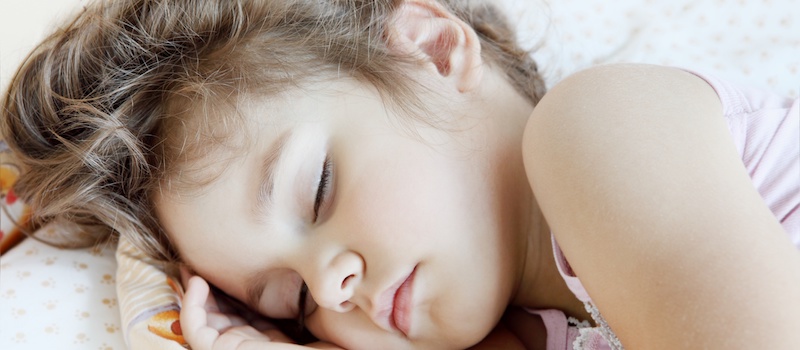Maybe your child’s snoring is so extreme and stilted that you’ve grown concerned. Maybe it’s hard to get your child up in the morning, or you’re getting notes from teachers about your child falling asleep in class. These are common symptoms of obstructive sleep apnea (OSA), a sleep disorder estimated to affect 1 to 4 percent of children. It can affect children of any age, and it can impact everything from your child’s energy levels to overall growth and development.
What Is Obstructive Sleep Apnea?
During sleep, we breathe deeply, relax and rest our head and neck in comfortable positions. In children with OSA, the loose, relaxed tissues in the throat fall over the airway or are collapsed in by deep breathing. Air flow is blocked for ten seconds or more. The brain realizes something is wrong and wakes the child up to restart breathing. Many children never remember waking. The cycle can repeat itself up to 70 times an hour, and the child is robbed of restful sleep and consistent blood oxygen levels.
The symptoms go beyond daytime sleepiness. Infants with OSA may not gain weight or grow at a normal rate. At least one study found a significant link between issues like OSA and both hyperactivity and inattention issues in children. Sleep is an integral part of every child’s physical and mental development.
Symptoms of OSA include:

- Abnormal breathing, snoring, gasping or choking during sleep
- Rib cage pulling in on inhalation during sleep
- Nighttime restlessness, including frequent shifting or waking
- Nightmares
- Sleepwalking
- Bedwetting
- Sleeping with the head and neck in unusual, elongated positions
- Night sweats
- Difficulty waking
- Daytime sleepiness
- Headaches
- Hyperactivity and inattentiveness
- Irritability and aggressive behavior
- Daytime mouth breathing
- Cardiovascular problems, including high blood pressure
- Slowed growth rate or failure to thrive
What Causes OSA?
The structures in our throats firm up and strengthen as we age. Children’s softer structures can be more prone to collapsing, specially in preschool-aged children. Weakness in the muscles supporting the throat and the added weight of childhood obesity can be contributing factors.
The leading cause of OSA in children over the age of 2 is enlarged tonsils and adenoids. Tonsils and adenoids are lumps of lymph tissue that filter incoming air, detecting germs and launching early immune responses. When they become chronically inflamed, they can easily block the airway.
Risk factors for OSA include:
- Enlarged tonsils or adenoids, which can be triggered by chronic infection, allergies and exposure to tobacco smoke
- Having a small jaw, chin or throat
- Having an unusually large tongue
- Cleft palate
- Childhood obesity
- Problems with muscle tone, commonly from conditions like muscular dystrophy or cerebral palsy
- Family history
How is OSA Diagnosed?
Sleep apnea is diagnosed with polysomnography, also called a sleep study. You and your child will go to a sleep center around your child’s normal bedtime. You’ll be able to stay in the center the entire time the study is being conducted. You’ll be able to bring some personal items to make your child feel more comfortable and spend some time in the center with them before the study is conducted.
During a sleep study, doctors monitor your child’s:
- Sleep and wake rates and patterns
- Breathing patterns, including snoring and other sounds
- Brain waves
- Blood oxygen level
- Heart rate
- Eye movements
- Body movements and sleep positions
Sleep studies are painless and non-invasive. Everything is monitored through external sensors, like stick-on electrodes and clip-on nose sensors. Video will also be taken for doctors to review.
How is OSA Treated?
Treatment for obstructive sleep disorders vary based on the underlying cause. For children with enlarged tonsils and adenoids, a tonsilectomy and adenoidectomy resolves up to 90% of cases. For other children, structural problems may correct with age. A CPAP machine, which increases air pressure in the throat, may be used to improve sleep in the meantime.
Childhood obesity and OSA can be reciprocal. Sometimes, a child’s difficulty sleeping lowers their energy levels, impacts their metabolism and contributes to their weight problems. The added weight then worsens their OSA. A combination of therapies, like CPAP and weight loss programs, might be recommended to address both sides of the issue.
Seeing an OSA Specialist
If you suspect your child is suffering from obstructive sleep apnea, it’s important to consult with a sleep disorder specialist. Call Pediatric ENT of Oklahoma today to schedule an appointment with one of our sleep and OSA specialists.

